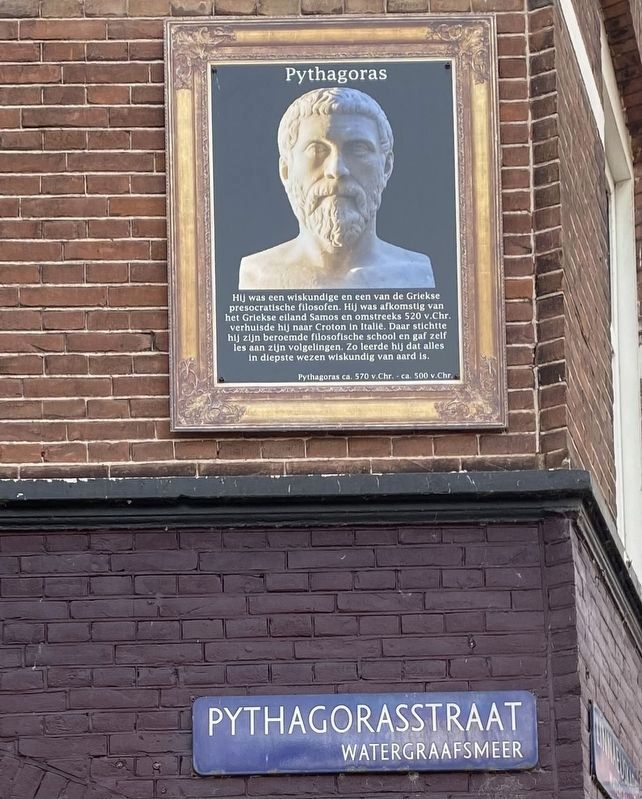Watergraafsmeer in Amsterdam, North Holland, Netherlands — Northwestern Europe
Pythagoras
Hij was een wiskundige en een van de Griekse presocratische filosofen. Hij was afkomstig van het Griekse eiland Samos en omstreeks 520 v.Chr. verhuisde hij naar Croton in Italie. Daar stichtte hij zijn beroemde filosofische school en gaf zelf les aan zijn volgelingen. Zo leerde hij dat alles in diepste wezen wiskundig van aard is.
(English translation:)
Pythagoras was a mathematician and one of the Greek pre-socratic philosophers. He came from the Greek island of Samos and around 520 BC. he moved to Croton, in Italy. There he founded his famous philosophical school, where he himself taught his followers. In this way he learned that everything is mathematical in nature.
Erected by Geef Straten Een Gezicht.
Topics and series. This historical marker is listed in this topic list: Science & Medicine. In addition, it is included in the Give Streets a Face / Geef Straten Een Gezicht, and the Scientists (GSEG) series lists.
Location. 52° 21.372′ N, 4° 55.923′ E. Marker is in Amsterdam, Noord-Holland (North Holland). It is in Watergraafsmeer. Marker is at the intersection of Pythagorasstraat and Linnaeuskade, on the left when traveling west on Pythagorasstraat. Touch for map. Marker is at or near this postal address: Linnaeuskade 30, Amsterdam, Noord-Holland 1098 BG, Netherlands. Touch for directions.
Other nearby markers. At least 8 other markers are within walking distance of this marker. Linnaeus (about 180 meters away, measured in a direct line); Isaac Newton (approx. 0.3 kilometers away); Laplace (approx. 0.4 kilometers away); Copernicus (approx. 0.4 kilometers away); Archimedes (approx. half a kilometer away); Gallileď / Galileo (approx. half a kilometer away); Transvaalbuurt Jewish Deportation Memorial (approx. 0.6 kilometers away); Concentratiebuurt / “Concentration”-hood (approx. 0.6 kilometers away). Touch for a list and map of all markers in Amsterdam.
Also see . . .
1. Pythagoras (Wikipedia).
Excerpt: Pythagoras of Samos (Ancient Greek: Πυθαγόρας ὁ Σάμιος, romanized: Pythagóras ho Sámios, lit. 'Pythagoras the Samian', or simply Πυθαγόρας; Πυθαγόρης in Ionian Greek; c. 570 – c. 495 BC) was an ancient Ionian Greek philosopher and the eponymous founder of Pythagoreanism. His political and religious teachings were well known in Magna Graecia and influenced the philosophies of Plato, Aristotle, and, through them, the West in general…. In antiquity, Pythagoras was credited with many mathematical and scientific discoveries, including the Pythagorean theorem, Pythagorean tuning, the five regular solids, the Theory of Proportions, the sphericity of the Earth, and the identity of the morning and evening stars as the planet Venus. It was said that he was the first man to call himself a philosopher ("lover of wisdom") and that he was the first to divide the globe into five climatic zones. Classical historians debate whether Pythagoras made these discoveries, and many of the accomplishments credited to him likely originated earlier or were made by his colleagues or successors. Some accounts mention that the philosophy associated with Pythagoras was related to mathematics and that numbers were important, but it is debated to what extent, if at all, he actually contributed to mathematics or natural philosophy.(Submitted on November 20, 2022.)
2. Pythagoras (Stanford Encyclopedia of Philosophy). (Submitted on November 20, 2022.)
Credits. This page was last revised on December 31, 2023. It was originally submitted on November 20, 2022, by Andrew Ruppenstein of Lamorinda, California. This page has been viewed 87 times since then and 7 times this year. Photos: 1, 2. submitted on November 20, 2022, by Andrew Ruppenstein of Lamorinda, California.

